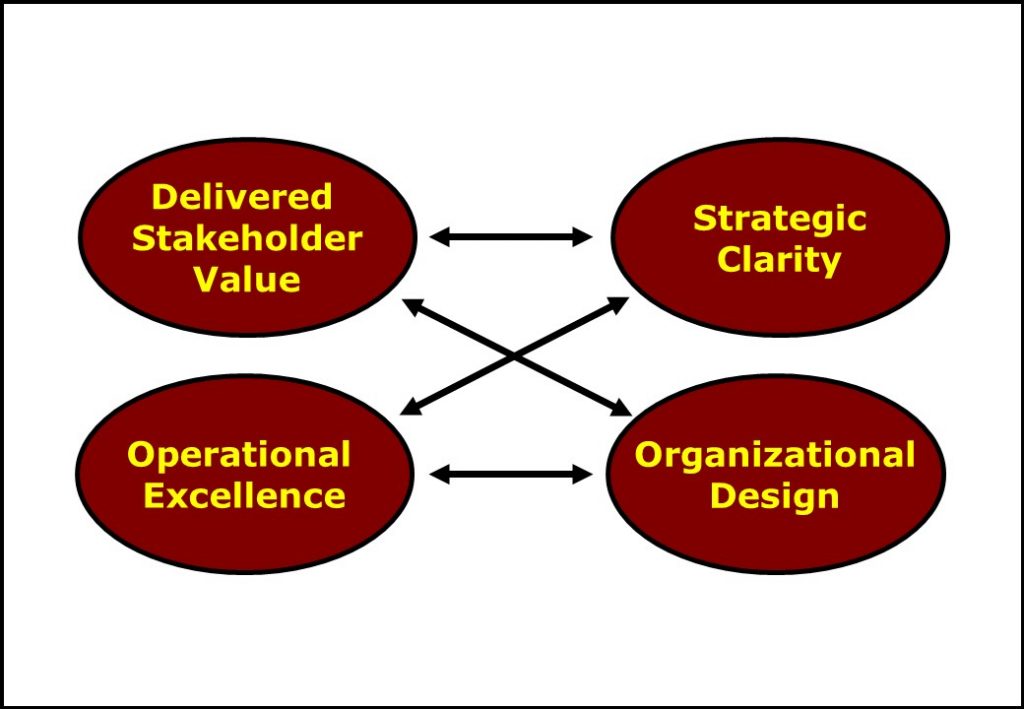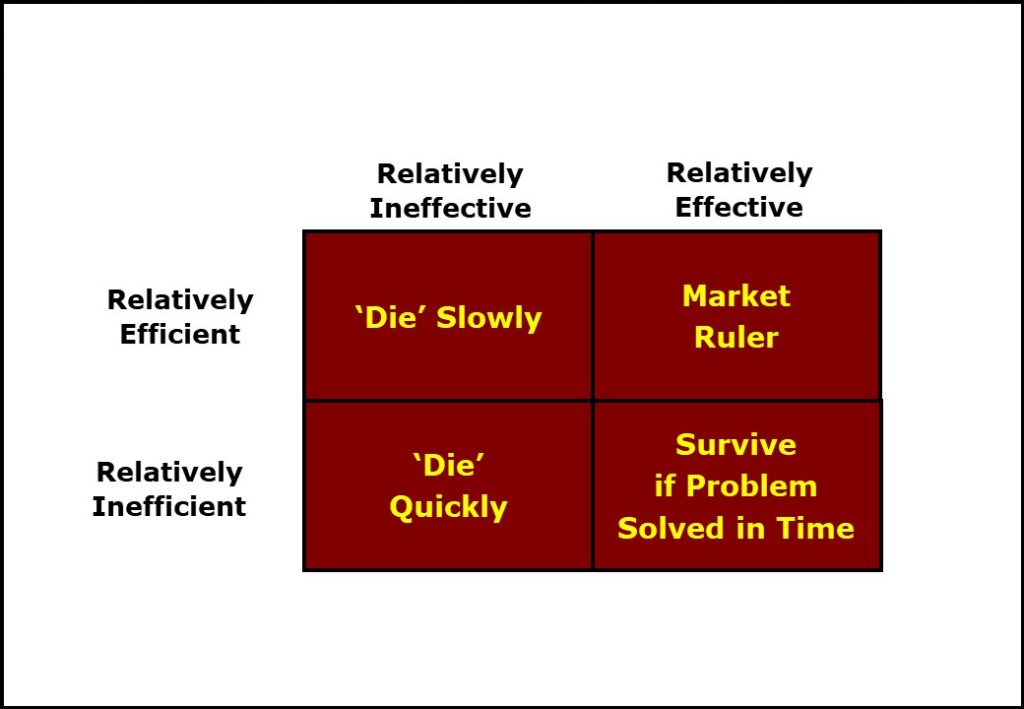1st March 2019
Outside Fortress Europe Excerpts
This second foundation Global Business Strategy Blog essay is based upon unabridged excerpts from Chapter One, Globalization Forces and Organizational Change, in Outside Fortress Europe: Strategies for the Global Market.
Outside Fortress Europe Excerpt
Introduction
What we have aimed to achieve thus far in Outside Fortress Europe is to set the scene for several key themes which permeate each of the book’s chapters regardless of the discipline-subject-topic being discussed therein. Figure 1 presents the four dimensions of Global Business Strategy and captures the relationships between them, the double-headed arrows indicating a nexus of inter-connectivity between the elements.

The schematic presented in Figure 1 belies the complexity which underpins it: everything connects with everything else. There are far too many compartments in business organizations and management science, whether these be in the functional silos of global companies or the departmental structures of otherwise world-class business schools.
Global business strategy: A themed approach
The competitive landscape and strategy creation emerge from the way that a company interprets its business environment. Assessment of this environment’s complexity and the determination of appropriate responses to the continuity and change dynamics it generates requires that the company sustains itself as an open learning system, acquiring, interpreting and processing information at all organizational levels and across all functions. This intangible but essential capability for creative environmental assessment conveys a key organizational strength, a strategic asset that demands that leaders facilitate a continuous process of learning and action.
Reverting to Figure 1, it should be clear from the major discontinuities discussed in the tumultuous decade which has been documented thus far is that primacy in strategy creation and organizational design must be given to the understanding of Market Environments, and it is worthwhile noting here that strategy doesn’t exist, or isn’t created, in a vacuum. We should also be aware that the commonly prescribed strategy question ‘Where are we now?’, captured, for example, in a traditional SWOT analysis, should not be considered in isolation of the related question ‘How did we come to be where we are now?’ An organization’s history, including its structural and cultural baggage, very often conflicts with the response to a third question, ‘Where do we want/need to be in the future?’ The answer to the fourth question, ‘How do we get there?’, is the logical outcome of the analyses undertaken in the previous three. We demonstrate this from a strategic management perspective in Chapter Five, Analysing Global Markets and the Intelligent Company and, operationally, in Chapter Seven, A Practical Framework for Global Business Strategy Success.
Regardless of the disciplines/subjects/topics/frameworks/processes/tools etc. being discussed throughout the book, there are four key themes that permeate its content. These are shown in Figure 2 and described in the paragraphs which follow.

Delivered Stakeholder Value is the focus of the final chapter of the book, A Stakeholder Perspective on Global Business Strategy. But it also appears as a theme throughout its chapters, for example, with regard to delivering customer value (see ‘Customer Value, Generic Strategies and Price Implications’, in Chapter Six, Strategic Marketing and Global Brand Management) or securing employee engagement (featured under the heading, ‘Internal Marketing for External Global Business Strategy Success’, in Chapter Eight, Implementing Global Business Strategy).
Organizational Design is a principal focus of Chapter Two, Strategic Planning and Organizational Design for Global Business Strategy: A Historical Perspective, but it also features heavily in the Chapters of Part Three of the book, Creating Organizational Advantage.
Strategic Clarity is a measure of effectiveness. Described by Professor Peter Drucker as “doing the right things”, effectiveness is the driving force behind customer-focused, competitively differentiated companies. It has a long-term time horizon and is associated with companies who think strategically and, from a marketing perspective, identify and select target customer segments where they can successfully align their organizational capabilities with the identified market opportunity. Effectiveness-dominant companies typically demonstrate an external, ‘outside-in’ orientation, a theme we adopt throughout the book.
Operational Excellence is a measure of efficiency. Described by Drucker as “doing things right”, efficiency aims to maximize the potential output from the provision of minimum inputs and is normally associated with a short to medium-term time horizon. In management studies, efficiency is most often associated with manufacturing and operations management but, as a metric, it can be applied to all types of marketing investments (Doyle, 2008). A typical example in everyday marketing use is ‘bang-per-buck’ when applied to advertising expenditures, the goal being to achieve the widest market coverage at the lowest possible cost, a perfect example being the success of Google Ads, Facebook and Twitter in the contemporary social media era. More generally, efficiency-dominant companies typically demonstrate an internal, ‘inside-out’ orientation.
While efficiency is essential for the achievement of operational excellence, ‘efficiency drives’, a mainstay of corporate parlance and day-to-day business operations, must not compromise customer value. Despite this, Drucker has convincingly argued that companies, especially larger ones, tend to focus excessively on performance metrics associated with efficiency and that this potentially leads to a vicious cycle towards organizational entropy. This is a complex concept with deep research roots in organizational behaviour, a discipline that is the prime focus of Part Three of the book, Creating Organizational Advantage.
As we approach the end of this Chapter, it should be noted that many organizational concepts are often discussed from an absolute perspective, for example, “Company A is very efficient”. However, when referring to organizations operating in competitive markets it is essential to provide a relative perspective, particularly when assessing companies from the same sector. So, for example, we should state that “Company A is more efficient than Company B in Sector 1”. Figure 3 presents a simple 4-cell matrix that contrasts companies from a hypothetical market sector on their relative effectiveness/efficiency axes and indicates the impact each cell position has on competitive advantage and, implicitly, on long term profitability.

Concluding remarks
A major problem with the discussion of organizational concepts in the management literature is that they are often presented as static phenomena. As demonstrated throughout this chapter, in the contemporary business environment markets are extremely dynamic and relatively strong market positions can be rapidly gained or lost. For example, BMW and Mercedes survived the market entry of Lexus into their high-end automotive market space, particularly in the lucrative US market, but only by retooling their German-based manufacturing operations and relocating some elements of production outside of Germany to offset the relative currency disadvantage of exporting out of the Deutschmark economy of the time. During this process, both German marques also maintained their strong customer franchises with model updates and heritage-focused (‘Made in Germany’) brand communications (see Chapter Six, Strategic Marketing and Global Brand Management).
Contrast this automotive case scenario with Nokia and Blackberry and their struggle to compete with Apple (iOS) and Samsung (Android), the new market leaders in mobile communications. The customer benefit in this category has shifted from ‘connecting people’ (the famous slogan of Nokia) to, broadly speaking, ‘sharing experiences’, the latter achieved through the combination of smartphones and social networks/media such as Facebook, Twitter, Instagram, Snapchat, Tinder etc.
Recommended resources for further inquiry
For the most authoritative textbook on the operational management dimensions of strategic management, including an excellent overview of its global aspects, the author’s recommended textbook, based upon the multiple criteria introduced in the ‘Introduction to the Global Business Strategy Blog’ and extracted here is: Slack et al. (2016), Operations Management.
For readers interested in a more detailed exploration of the subject of strategy, the author’s recommended textbook, based upon the same criteria is: Johnson et al. (2017), Exploring Strategy: Text and Cases. This publication has long been recognised for the quality, depth and range of its case studies, some quite short and explanatory, others longer and thought-provoking.
For readers interested in a more detailed exploration of the subject of international business, the author’s recommended textbook, based upon the same criteria, is: Collinson et al. (2016), International Business.
The author’s recommended textbook relating to the subject of organizational behaviour, based upon the same criteria, is: Buchanan and Huczynski (2016), Organizational Behaviour.
In this book we also draw heavily on Christopher (2016), Logistics and Supply Chain Management, a discipline which we describe as the ‘backbone’ of strategic marketing management: it combines the twin market disciplines of demand generation and order fulfilment, in the process addressing the effectiveness/efficiency dynamic introduced in this chapter and developed throughout the book.
Outside Fortress Europe Excerpt References
Buchanan, D., & Huczynski. (2016). Organizational Behaviour. Harlow: Pearson.
Christopher, M. (2016). Logistics and Supply Chain Management (5 ed.). Harlow: Pearson.
Collinson, S., Narula, R., & Rugman, A. M. (2016). International Business (7 ed.). Harlow: Pearson.
Doyle, P. (2008). Value-Based Marketing: Marketing Strategies for Corporate Growth and Shareholder Value (2 ed.). Chichester: John Wiley & Sons.
Drucker, P. F. (1974). Management: Tasks, Responsibilities, Practices. London: Heinemann Professional Publishing.
Slack, N., Brandon-Jones, A., & Johnston, R. (2016). Operations Management (8 ed.). Harlow: Pearson.
Please click/tap your browser ‘Back’ button to return to the location navigated from. Alternatively, click/tap the ‘Antique Keyboard’ graphic below to navigate to The Global Business Strategy Album page.
All content © Colin Edward Egan, 2022

